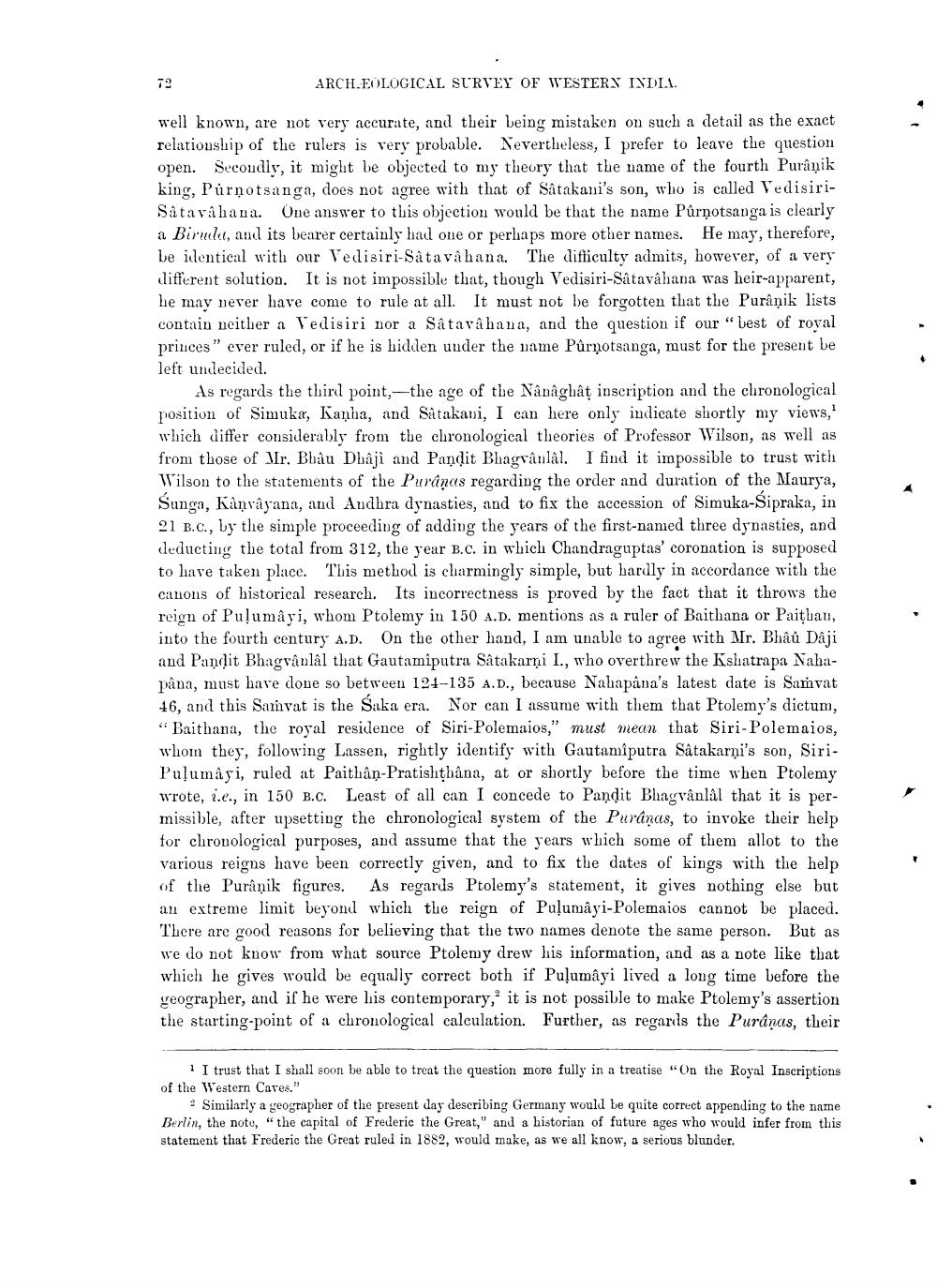________________
72
ARCHEOLOGICAL SURVEY OF WESTERX IXDI.1.
well known, are not very accurate, and their being mistaken on such a detail as the exact relatiouship of the rulers is very probable. Nevertheless, I prefer to leave the question open. Secondly, it might be objected to my theory that the name of the fourth Puranik king, Purņotsanga, does not agree with that of Satakani's son, who is called VedisiriSatavahana. One answer to this objection would be that the name Půrņotsanga is clearly a Birnila, and its bearer certainly had one or perhaps more other names. He may, therefore, be identical with our Vedisiri-Satavahana. The difficulty admits, however, of a very different solution. It is not impossible that, though Vedisiri-Satavahana was heir-apparent, he may never have come to rule at all. It must not be forgotten that the Puranik lists contain neither a Vedisiri nor a Satavahana, and the question if our " Lest of roval princes" ever ruled, or if he is hidden under the name Purņotsanga, must for the present be left undecided.
As regards the thiril point, the age of the Nânâghât inscription and the chronological position of Simuka, Kanha, and Satakani, I can here only indicate shortly my views, which differ considerably from the chronological theories of Professor Wilson, as well as from those of Mr. Bhâu Dhaji and Pandit Bhagrâulàl. I find it impossible to trust with Wilson to the statements of the Puranas regarding the order and duration of the Maurya, Sunga, Kåņvâyana, and Andhra dynasties, and to fix the accession of Simuka-Sipraka, in 21 B.C., by the simple proceeding of adding the years of the first-named three dynasties, and deducting the total from 312, the year B.c. in which Chandraguptas' coronation is supposed to have taken place. This method is charmingly simple, but hardly in accordance with the canons of historical research. Its incorrectness is proved by the fact that it throws the reign of Pulumâyi, whom Ptolemy in 150 A.D. mentions as a ruler of Baithana or Paithau, into the fourth century A.D. On the other hand, I am unable to agree with Mr. Bhâû Daji and Pandit Bhagvanlal that Gautamiputra Satakarņi I., who overthrew the Kshatrapa Nahapâna, must have done so between 121-135 A.D., because Nahapana's latest date is Samvat 46, and this Samvat is the Saka era. Nor can I assume with them that Ptolemy's dictum, * Baithana, the royal residence of Siri-Polemaios," must mean that Siri-Polemaios, whom they, following Lassen, rightly identify with Gautamiputra Satakarņi's son, SiriPulumâyi, ruled at Paithân-Pratishthana, at or shortly before the time when Ptolemy wrote, i.e., in 150 B.C. Least of all can I concede to Pandit Bhayvanlal that it is permissible, after upsetting the chronological system of the Puranas, to invoke their help for chronological purposes, and assume that the years which some of them allot to the various reigns have been correctly given, and to fix the dates of kings with the help of the Puranik figures. As regards Ptolemy's statement, it gives nothing else but an extreme limit beyond which the reign of Puļumâyi-Polemaios cannot be placed. There are good reasons for believing that the two names denote the same person. But as we do not know from what source Ptolemy drew his information, and as a note like that which he gives would be equally correct both if Puļumâyi lived a long time before the veographer, and if he were his contemporary, it is not possible to make Ptolemy's assertion the starting-point of a chronological calculation. Further, as regards the Puranas, their
1 I trust that I shall soon be able to treat the question more fully in a treatise "On the Royal Inscriptions of the Western Caves."
Similarly a yeographer of the present day describing Germany would be quite correct appending to the name Berlin, the noto, "the capital of Frederic the Great," and a historian of future ages who would infer from this statement that Frederic the Great ruled in 1882, would make, as we all know, a serious blunder.




